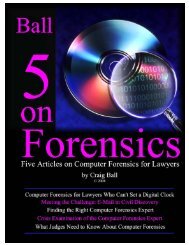Six Articles on Electronic - Craig Ball
Six Articles on Electronic - Craig Ball
Six Articles on Electronic - Craig Ball
Create successful ePaper yourself
Turn your PDF publications into a flip-book with our unique Google optimized e-Paper software.
<strong>Craig</strong> <strong>Ball</strong> © 2007<br />
The DNA of Data<br />
By <strong>Craig</strong> <strong>Ball</strong><br />
[Originally published in Law Technology News, April 2005]<br />
Discovery of electr<strong>on</strong>ic data compilati<strong>on</strong>s has been part of American litigati<strong>on</strong> for two<br />
generati<strong>on</strong>s, during which time we’ve seen nearly all forms of informati<strong>on</strong> migrate to the digital<br />
realm. Statisticians posit that <strong>on</strong>ly five to seven percent of all informati<strong>on</strong> is “born” outside of a<br />
computer, and very little of the digitized informati<strong>on</strong> ever finds its way to paper. Yet, despite the<br />
central role of electr<strong>on</strong>ic informati<strong>on</strong> in our lives, electr<strong>on</strong>ic data discovery (EDD) efforts are<br />
either overlooked altogether or pursued in such epic proporti<strong>on</strong>s that discovery dethr<strong>on</strong>es the<br />
merits as the focal point of the case. At each extreme, lawyers must bear some resp<strong>on</strong>sibility<br />
for the failure. Few of us have devoted sufficient effort to learning the technology, instead<br />
deluding ourselves that we can serve our clients by c<strong>on</strong>tinuing to focus <strong>on</strong> the smallest, stalest<br />
fracti<strong>on</strong> of the evidence: paper documents. When we do garner a little knowledge, we abuse it<br />
like the Sorcerer’s Apprentice, by demanding producti<strong>on</strong> of “any and all” electr<strong>on</strong>ic data and<br />
insisting <strong>on</strong> preservati<strong>on</strong> efforts sustainable <strong>on</strong>ly through operati<strong>on</strong>al paralysis. We didn’t know<br />
how good we had it when discovery meant <strong>on</strong>ly paper.<br />
However, electr<strong>on</strong>ic evidence isn’t going away. It’s growing…exp<strong>on</strong>entially, and some<br />
electr<strong>on</strong>ic evidence items, like databases, spreadsheets, voice mail and video, bear increasingly<br />
less resemblance to paper documents. Proposed changes in the rules of procedure wending<br />
their way through the system require lawyers to discuss ways to preserve electr<strong>on</strong>ic evidence,<br />
select formats in which to produce it and manage volumes of informati<strong>on</strong> dwarfing the Library of<br />
C<strong>on</strong>gress. Litigators must learn it or find a new line of work.<br />
My goal for this column is to help make electr<strong>on</strong>ic discovery and computer forensics a little<br />
easier to understand, never forgetting that this is exciting, challenging—and very cool—stuff.<br />
Accessible versus Inaccessible<br />
You can’t talk about EDD today without using the “Z” word: Zubulake (pr<strong>on</strong>ounced “zoo-boolake”).<br />
Judge Shira Scheindlin’s opini<strong>on</strong>s in Zubulake v. UBS Warburg, L.L.C., 217 F.R.D. 309<br />
(S.D.N.Y. 2003) triggered a whirlwind of discussi<strong>on</strong> about EDD. Judge Scheindlin cited the<br />
“accessibility” of data as the threshold for determining issues of what must be produced and<br />
who must bear the cost of producti<strong>on</strong>. Accessible data must be preserved, processed and<br />
produced at the producing party’s cost, while inaccessible data is available for good cause and<br />
may trigger cost shifting.<br />
But what makes data “inaccessible?” Is it a functi<strong>on</strong> of the effort and cost required to make<br />
sense of the data? If so, do the boundaries shift with the skill and resources of the producing<br />
party such that ignorance is rewarded and knowledge penalized? To understand when data is<br />
truly inaccessible requires a brief look at the DNA of data.<br />
Everything’s Accessible<br />
Computer data is simply a sequence of <strong>on</strong>es and zeroes. Data is <strong>on</strong>ly truly inaccessible when<br />
you can’t read the <strong>on</strong>es and zeroes or figure out where the sequence starts. To better grasp<br />
this, imagine you had the unenviable resp<strong>on</strong>sibility of typing the complete works of Shakespeare<br />
<strong>on</strong> a machine with <strong>on</strong>ly two keys, “A” and “B,” and if you fail, all the great works of the Bard<br />
66













